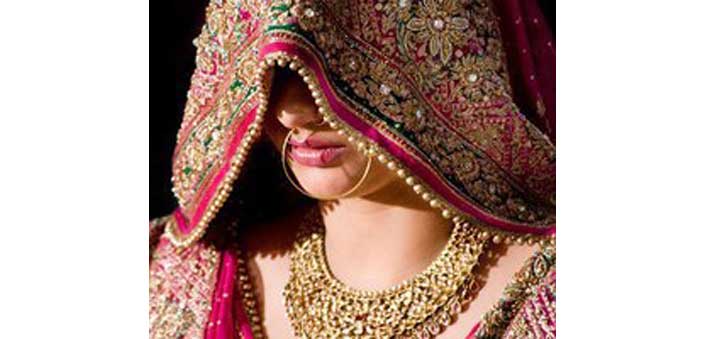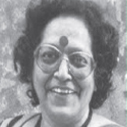In a contemporary global world, this head covering of a married woman holds significance that reaches far beyond a simple marriage ritual. Is it a reinstatement of social distance maintained by the bride once she is married? Or is it a space for privacy for the young bride? It is also a marker for the husband who begins to ‘possess’ his bride. Some say it symbolises cultural identity that gives others indicators about how to communicate with the bride. Today, for most women across the world, the bridal veil or ghunghat are
ornamentations that enhance the bride’s femininity by investing her with the coyness considered ‘politically correct for a newly married bride.
The bride’s head is covered during a wedding in almost all parts of the world. This is a rite that is a custom dictated by tradition. In Hindu societies, particularly in the Northern and Eastern states, the bride kept her head covered in her matrimonial home even after she was married and became old. It was a mark of respect towards elders in the family. The lifting of the veil or ghunghat was a part of ancient wedding ritual, symbolising the groom taking possession of the wife, either as lover or as property, or the revelation of the bride by her parents to the groom for his approval. The ghunghat or the veil or chunri was sometimes interpreted as a cover for the face, or a disguise.
In times of yore, a sign of chastity and decency in married women was to cover their faces with the ghunghat in the presence of strangers. The putting on of the veil marked the transition from girlhood to womanhood.
Historical origin
The first recorded instance of veiling is in an Assyrian legal text from the 13th century BC, which restricted its use to noble women and forbade prostitutes and common women from adopting it.
Ancient Greek texts have spoken of veiling and seclusion of women practiced among the Persian elite. Statues from Persepolis depict women both veiled and unveiled. Surprisingly, it was supposedly regarded as an attribute of prostitution. Classical Greek and Hellenistic statues sometimes depict Greek women with both their head and face covered by a veil.
In Christian weddings, brides would wear their hair flowing down their backs at their weddings. It was a symbol of their virginity. The white diaphanous veil is now a substitute for the same virginity. In ancient times, Roman brides wore a flame-coloured veil called the flammeum, said to protect the bride from evil spirits on her wedding day. Today, the bridal veil, usually a thin, gossamer-like fabric, lasts till the bridal couple drive away from the church and is never worn again. Interestingly, Christian women wear a black, netted veil in mourning and when they attend a burial or a funeral.
In Judaism, the tradition of wearing a veil dates back to Biblical times. When Rebekah went to meet her betrothed, Isaac, she veiled herself as he approached her. The veiling was both a symbol of modesty, and a definition of her personal space. Rebekah is known as the most self-assured of the matriarchs, and by veiling herself she indicated that she would still be her own person even when she would be living her life with Isaac. Rebekah did not veil herself when travelling with men to meet Isaac, but only when he was present or approaching.
A variety of headdresses worn by Muslim women in accordance with hijab (the principle of dressing modestly) are sometimes referred to as veils. These cover the hair, ears and throat, but do not cover the face (for example the dupatta, khimar and buknuk.) The niqab and burqa are two kinds of veils that cover most of the face except for a slit or hole for the eyes. The Afghan burqa covers the entire body, obscuring the face completely, except for netting over the eyes to allow the wearer to see.
The boushiya is a veil that may be worn over a headscarf. It is made of sheer fabric. History says that the practice of wearing of the veil was uncommon among the Arabs before the rise of Islam. It originated in Byzantium, the original name of Istanbul. For Muslim women, the burqa and the headscarf have little to do with their marital status because little girls also wear it in public.
The veil has become a potent symbol of the Muslim identity in recent decades. Yet, it’s meaning for those who wear it, for those who see it being worn, for those who advocate the veiling of women, or reject it, is hardly uniform, and often ambiguous Ghoonghat or ghunghat is a Hindi word which describes a veil worn by Indian women to cover their heads.
Generally it is the pallu, the loose end of the sari that is pulled over the head by women in Uttar Pradesh, Bihar, West Bengal and so on. During a Bengali wedding, before the ceremony, the bride wears a separate, red veil that slightly covers her forehead but not her face. During the ceremony, the bridegroom smears her hair parting with sindoor and pulls the end of her wedding sari to cover her head, replacing the veil. She is then officially considered his bride. In Punjab and Haryana, brides use a long, red, heavily sequinned dupatta over their bridal salwar-kameez during the wedding. In Rajasthan, the bride wears a long chunri, usually bright red with sequins and a heavy zardozi border. The chunri, worn with a ghaghra choli, is tucked in at the waist on one end, pleated beautifully around the body and draped delicately over one shoulder.
The ghunghat is still a form of veiling of women, practiced in rural parts of Northern India, especially in Rajasthan. Among the Gujjar community in Rajasthan, for instance, the veil for the girl implies sexuality that needs to be protected. But when a married daughter comes to her parents’ village, she uncovers her head and never wears the veil because issues of sexuality do not arise. She is a daughter and sister to everyone in the village.
The Bengali veil
The ghomtaa (the Bengali word for the ghunghat) among Bengali aristocracy at the turn of the century had an interesting edge to it. It gave women the only opportunity to express their emotions through facial gestures others could not see. They could frown, smile, tease, grimace, stick their tongues out and even laugh silently under the cover of the ghomtaa and no one would know. A reprimand, an insult, could go unpunished because they were invisible. They could even take voyeuristic delight by sneaking peaks at their husbands and other men in the family without anyone knowing. On the other hand, she could shed silent tears of pain, of suffering, of helplessness, of loss because loud wailing was not permitted except when someone passed away. Weeping in front of others was not permitted.
When she goes back to her husband’s village, she covers her head again. So, the same ghunghat that signifies modesty in the husband’s village stands for wantonness in the parents’ village! Thus, the same woman who voices an ironic critique of a cultural practice embraces the same practice with its implications of sexuality to uphold her family’s honour that is integrally woven into her own. Strangely, the southern parts of India such as Tamil Nadu, Andhra Pradesh, Kerala and Karnataka, even Maharashtra do not have this custom during or after the wedding. But widows in most of these states would earlier cover their heads with the pallu of their simple saris. The reason was different. It was considered inauspicious to see their faces because of their widowed state!
The most democratic quality of the ghunghat, the veil, the chunri and the dupatta is that it crosses all barriers of moral codes for women across the world. Nuns wear hood or a veil along with their habit. The courtesan also covers her head. So do dancing girls. Veils are part of the stereotypical image of the courtesan and harem woman.
Rather than the virginity of the bride’s veil, the modesty of the Muslim scarf or the piety of the nun’s headdress, the mysterious veil for the courtesan is a symbol of the erotic, the sensual and the unknown.


